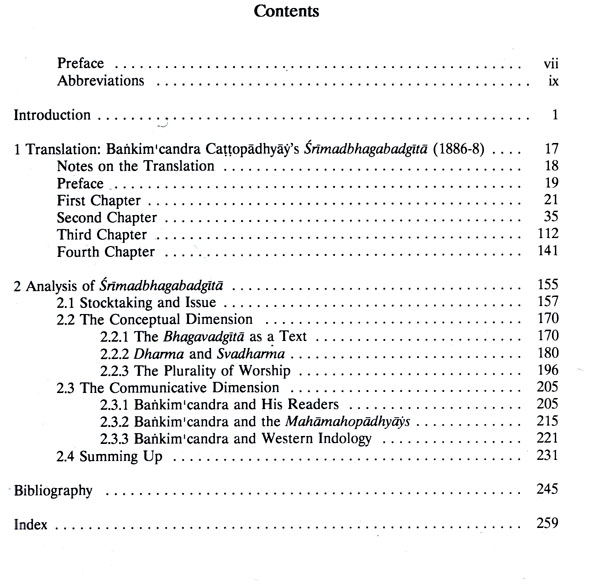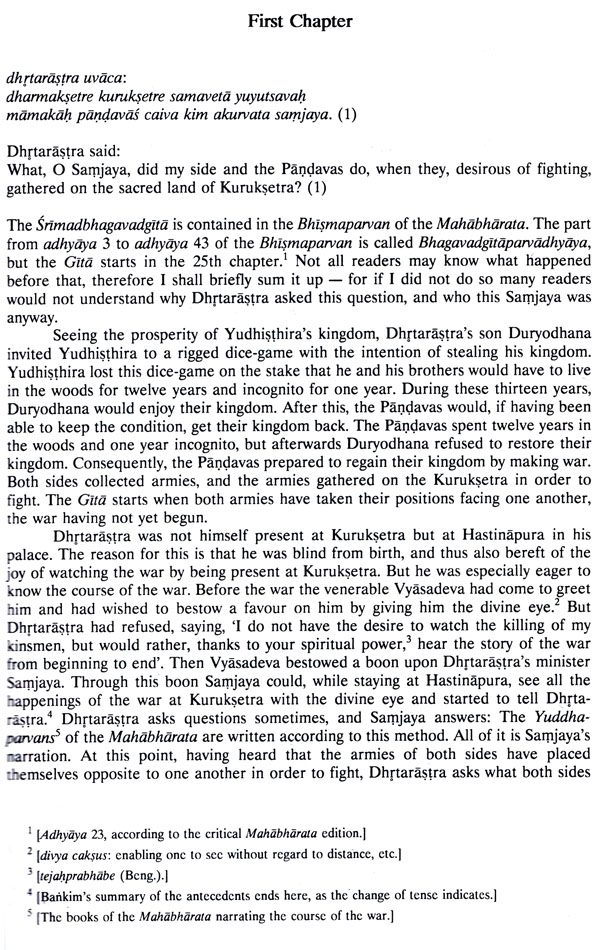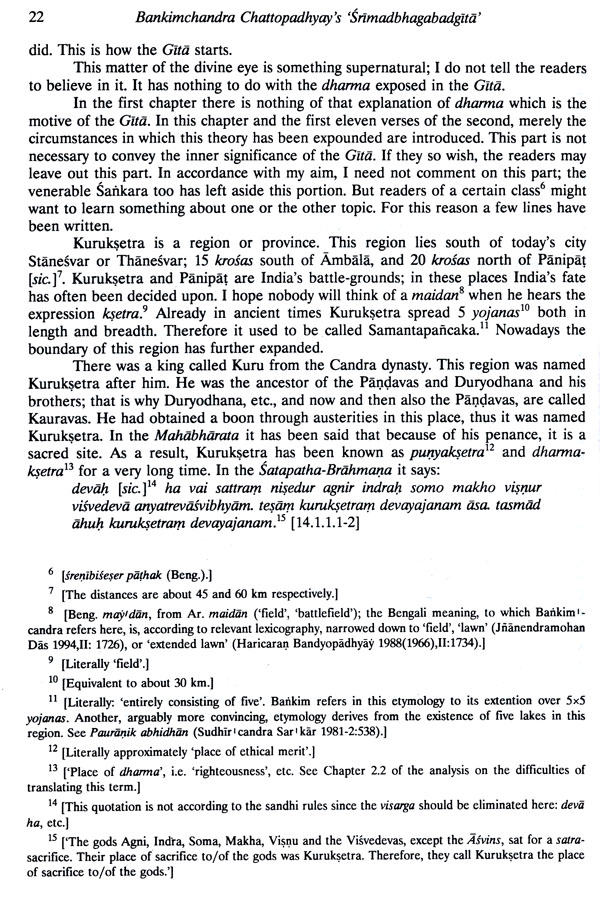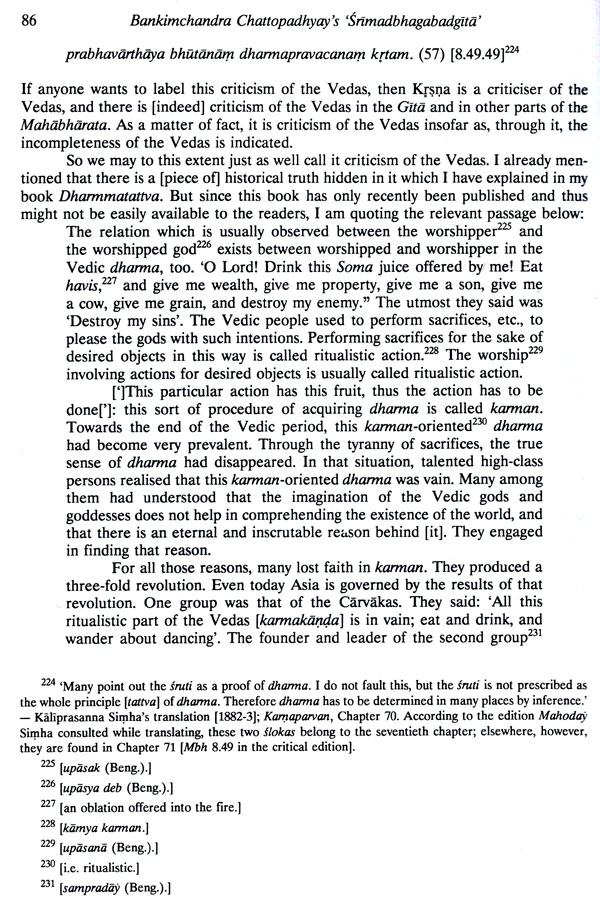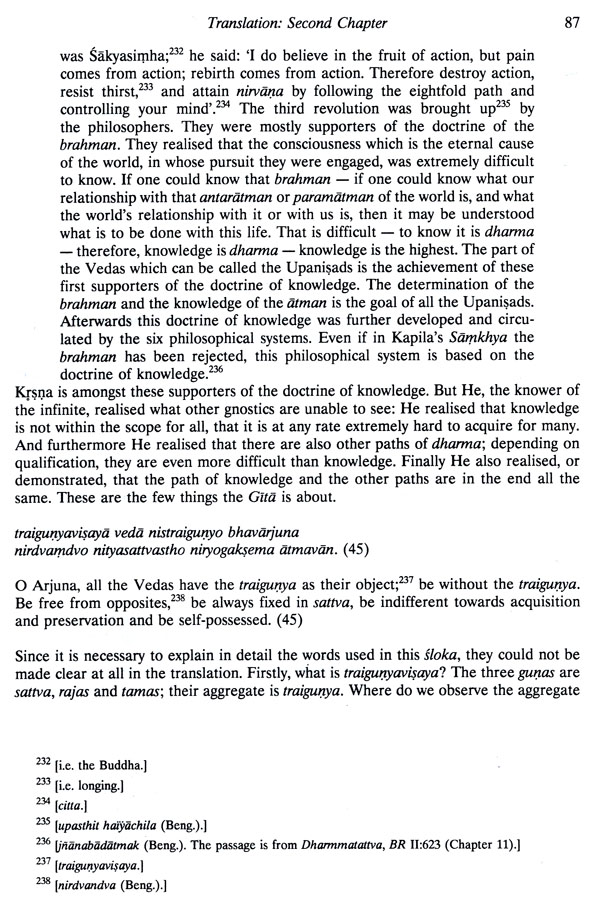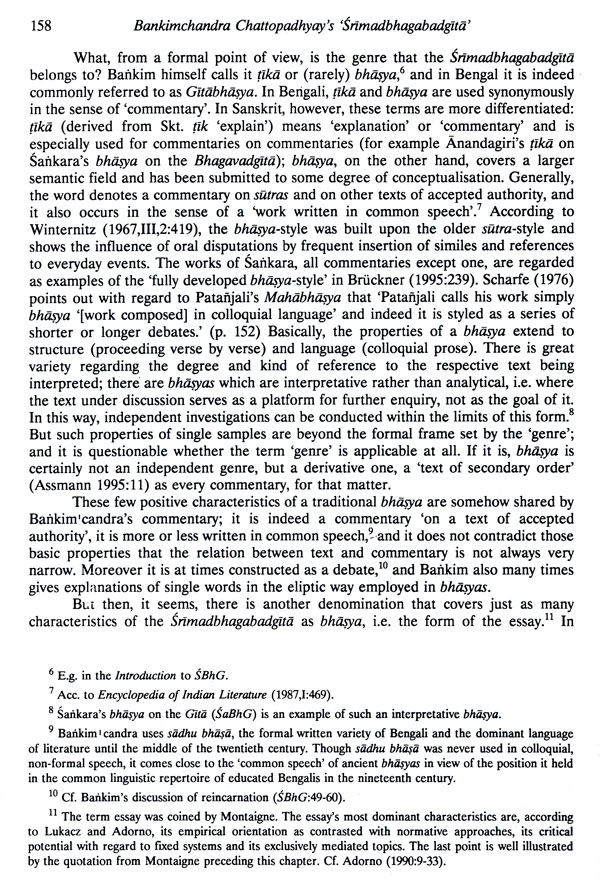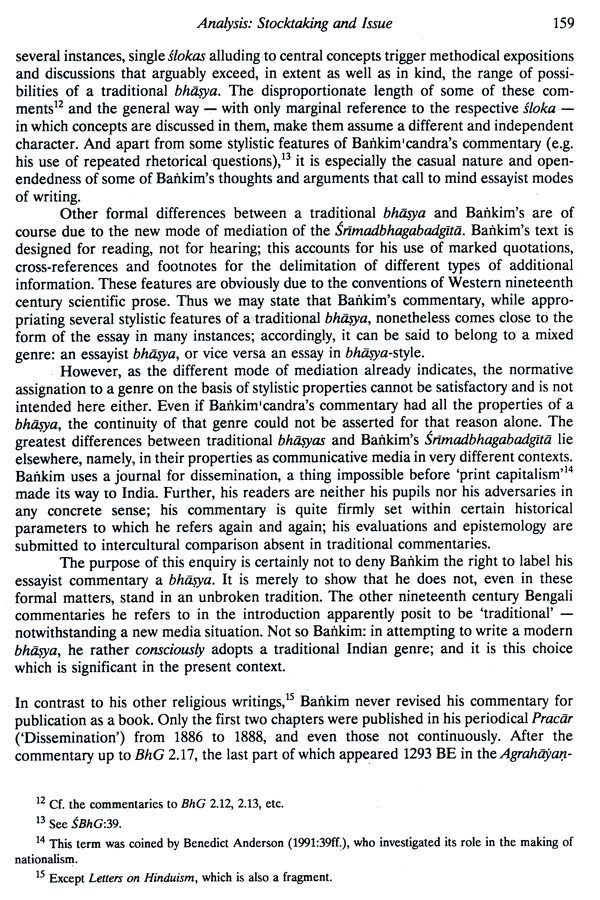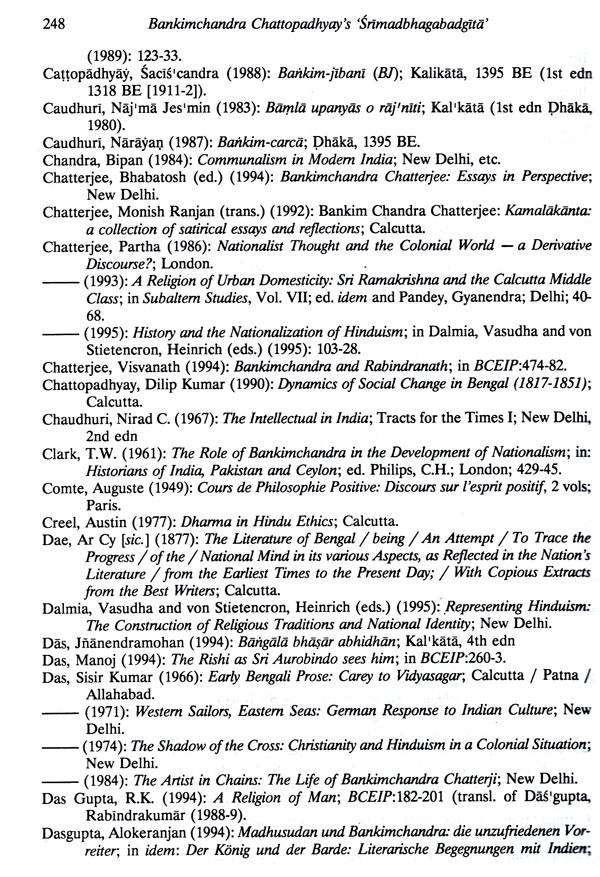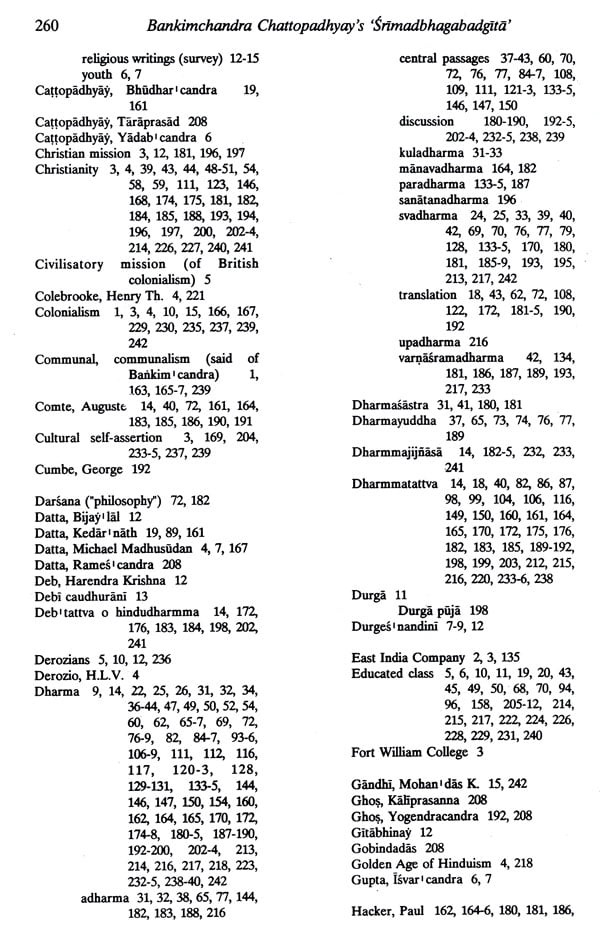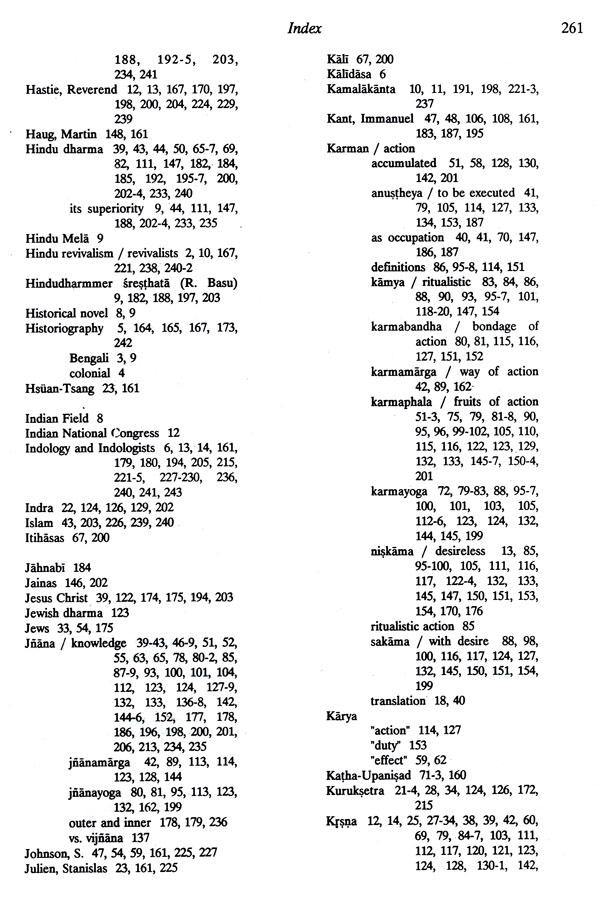
Bankimchandra Chattopadhyay's (Srimadbhagabadgita)
Book Specification
| Item Code: | NAZ838 |
| Author: | Hans Harder |
| Publisher: | Manohar Publishers and Distributors |
| Language: | English |
| Edition: | 2001 |
| ISBN: | 8173043760 |
| Pages: | 273 |
| Cover: | HARDCOVER |
| Other Details | 8.50 X 5.50 inch |
| Weight | 640 gm |
Book Description
This book is an attempt to re-examine Bankimchandra's religious thinking in the context of the nineteenth century on the basis of his Srimadbhagabadgita. Written in installments from 1886-88, his little-noted Gita commentary is a key text of nascent modern (or neo-) Hinduism. The mediation between East and West, science and religion, and the nationalist assertion that Gita-based Hinduism represents the most superior and universal religion, are its dominant features.
The analysis following the translation aims at identifying the tools Bankimchandra uses in trying to establish the superiority of Hinduism. His switching between normative and empirical definitions of terms enables him, e.g. to interpret the concept of dharma as the most universal formulation of religion. Likewise, in his apology for image-worship, Hinduism gets the bonus of being the most complete and most tolerant of all religions.
The nationalist intention of the commentary is equally evident in its communicative set-up. It is shown that ancient Indian Gita commentators are treated as in-group members, who are, whenever necessary, complemented away by means of a 'polite dismissal'. Western Indologists, by contrast, are sometimes cited as examples of utter incompetence, betraying the underlying intention of taking the authoritative discussion about India back to India.
In the conclusion, the interplay of intentions and constraints in Bankimchandra's thinking is integrated into a larger-scale assessment of his concept of Hindu-Indian identity and cultural self-assertion. Historically, Bankimchandra must indeed be regarded as one of the founders of 'Hindu nationalism' and an influential 'essentialize, despite the fact that the complexity of his thought would have allowed quite a different reception. Many of his interpretations, popularised by Vivekananda, Aurobindo, and others, have evolved into standard modern Hindu standpoints.
Bankim'candra Chattopadhyay's religious thought has attracted considerable attention among scholars from Bengal and elsewhere, and its role in the shaping of modern Hinduism has been duly recognized. Bankim'candra's Srimadbhagabadgita (1886-8/:901), his fragmentary commentary on the Bhagavad, occupies an important place among his religious writings but has so far been neglected in the ongoing discussion. In my following thesis, my primary aim is to make the text available to interested readers and scholars without knowledge of Bengali by furnishing a critical, documented English translation of it. The introduction preceding this translation cannot claim originality: it primarily meant to give an outline of the historical and biographical frame necessary for an evaluative and appreciative reading of the commentary. Special emphasis is ', raced on the mediation between Eastern and Western thought which has been so c-crucial in Bengali intellectual history since the beginning of the nineteenth century.
Bankim'candra's religious writings are closely interconnected. In my analysis allowing the translation, I have accordingly taken the opportunity to reconsider, in a micro-study, certain issues connected with his religious thought on the basis of the commentary while at the same time taking into account his other essays. The first chapter of the analysis contains a statement about some basic properties of the commentary, remarks on its publication history as well as a survey of prior research on the topic (so far lacking in this discussion), and notes about my procedure. In the second chapter, I have attempted to portray and critically examine a few of Bankim'candra's conceptions as formulated in the commentary and the surrounding writings: his view of the Gita as an authoritative religious text, his use and elaboration of the terms dharma and his notion regarding the plurality of worship in Hinduism. The communicative set-up of the commentary is the subject of the third chapter, in which I analyze the strategies Bankim'candra employs in dealing with his readers, the ancient commentators, and Western Indologists. In the course of this chapter, I have tried to find some clues regarding the location of the author Bankim'candra in his text. The final chapter regains a broader perspective on the topic, and focuses on an explanation of the inconsistencies inherent in Bankim'candra's interpretation of Hinduism as worked out in the preceding analysis. I have made an attempt to demonstrate that many arguments rely on the coexistence of broad and narrow definitions of central terms, as well as normative and empirical frames of judgment, playing out against one another. This pattern is often employed by Bankim'candra in order to establish the superiority of Hinduism over other religions, especially Christianity. His tendency towards cultural self-assertion, I will argue, is the basic impulse of the commentary, its ultimate ratio, and an outcome of the colonial situation in which Bankim'candra lived. This nationalist and proto-political character of Bankim'candra's writings also demonstrates their relevance beyond religious studies, namely, in the study of anti-colonialism, nationalism, etc. A short examination of the appropriateness of terms such as `neo-Hinduism' and 'modern Hinduism' concludes this chapter and the analysis.
Many of my teachers, colleagues, and friends have helped me write, this thesis: first of all, my teacher and examiner in Halle, Prof. Dr. Rahul Peter Das, inspired and encouraged me to choose this particular subject. He went through all I have written more than once, and without his advice and guidance, this work would have been difficult to achieve. I also wish to thank my former Bengali teacher Dr. Alokeranjan Daseupta (Heidelberg) for his help with this thesis, as well as for the way in which he taught me - and still teaches - Bengali literature. I am also grateful to my other examiners, Prof. Dr. Walter Slaje (Halle University) and Prof. Dr. Srinivasa Ayya Srinivasan (Hamburg University), for their most valuable help and corrections. Moreover, I wish to thank the Deutsche Morgenlandische Gesellschaft, who awarded me the DMG-Forschungspreis 1998 for this thesis; the editing board of South Asian Studies at the Siidasieninstitut Heidelberg for accepting it for publication in this series; and the Taraknath Das Stiftung (Berlin) for generously subsidizing the print of this book. Further thanks are due to the Graduiertenforderung of Hamburg University which granted me two years' scholarship for this undertaking; Prof. Dr. Albrecht Wezler (Hamburg University) and Prof. Dr. Dietmar Rothermund (Heidelberg University) for their expertise; Dr. Melitta Waligora (Humboldt-University Berlin) for valuable comments; Raja and Sulagna Mukhopadhyay (Calcutta) for their assistance and friendship; Dr. Shivaji Bandyopadhyay (Jadavpur University), Maphidul Hak, Dr. Badruddin Umar and Prof. Anisuzzaman (Dhaka) for controversial and challenging discussions; Dr. Birgit Mayer-Konig, Thomas Herzog, Prof. Dr. Jurgen Paul, Prof. Dr. Walter Beltz, Dirk Moras (Halle), Christian WeiB, Jorg Watzinger, Ursula Rao (Heidelberg), Dr. Susmita Mallick (Hamburg) and many others for their assistance in various ways. A special thanks go to Karin Harder for her support and the way in which she helped me structure my arguments and discover my thoughts.
The cover illustration of this book may need an explanatory remark. In the Hastie Controversy to be discussed in several instances, Bankim'candra, while defending idol worship, feels urged to admit that "the images we worship in Bengal are, as works of art_ a disgrace to the nation. Wealthy Hindus should get their Krishnas and Radhas made in Europe." (BR 111:216) Incidentally, thanks to Dr. Maria Schetelich from the Institut fur Indologie Zentralasienwissenschaften, University of Leipzig, I found the Art Nouveau Krishna temple "printed in Germany" around 1920 which is reproduced on the cover. The print of an anonymous painter is part of the Hertel collection which was donated to that institute by Mrs. Margarethe Hertel. I am not sure whether Bankim'candra would have appreciated this representation, but I could not resist the temptation to take him by his own words. I thank Dr. Schetelich and the Institut fur Indologie and Zentralasienwissenschaften for allowing me to reproduce the picture.
The manuscript of this book was finished in 1997, and it must be mentioned that the delay in publication is due to several things, but not to the present publisher. I thank Mr. Ramesh Jain and the Manohar staff for their copy editing, advice, and cooperation.
**Contents and Sample Pages**